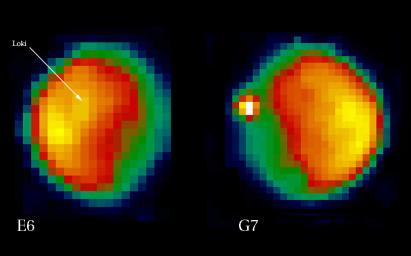Loki Patera, historically the most active and persistent hot spot on Io, is located on the hemisphere of Io always facing Jupiter. Loki Patera was the site of two plumes during the Voyager encounters, which were not seen during the early orbits of Galileo. Ground-based observers reported Loki Patera to be unusually dim during this time, marking a period of low volcanic activity.
On 21 February 1997, during Galileo's sixth orbit, the Near Infrared Mapping Spectrometer (NIMS) on the Galileo spacecraft observed Io in daylight from a range of approximately 703,000 km (440,000 miles). The image on the left shows Io at a wavelength of 2.95 microns. Loki Patera is seen to be relatively quiescent (at longer wavelengths which are more sensitive to thermal emission, Loki Patera is more noticeable).
A few weeks later, on March 12th 1997, ground based observers using the Infra-Red Telescope Facility (IRTF) on Mauna Kea, Hawaii, observed an intense brightening in the Loki region, so much that Loki was contributing 75% of Io's in-eclipse flux for this hemisphere. A large eruption was taking place! Other ground-based observations through March, April and May tracked the course of the activity and confirmed its location at Loki Patera.
On 4 April 1997, NIMS again observed Io during the seventh orbit from a range of 556,000 km (348,000 miles), with Loki Patera positioned in darkness, close to the limb. The image on the right shows the increase in activity at Loki Patera, again at 2.95 microns. A preliminary single temperature fit to NIMS orbit seven Loki Patera hot spot data yields a temperature of 500 K and an area of over 800 square kilometers. That the image is so bright at this wavelength is an indication of the areal extent of the activity. It is also probable that some part of the volcanic material being erupted or exposed is at considerably higher temperatures than that of the 500 K single-temperature fit.
Io is under observation by ground-based observers under the auspices of the International Jupiter Watch, which has a web site at http://www.lowell.edu/users/ijw/ijwhome.html
The Jet Propulsion Laboratory, Pasadena, CA manages the mission for NASA's Office of Space Science, Washington, DC. This image and other images and data received from Galileo are posted on the World Wide Web, on the Galileo mission home page at URL http://www.jpl.nasa.gov/galileo/sepo.

 Planetary Data System
Planetary Data System












